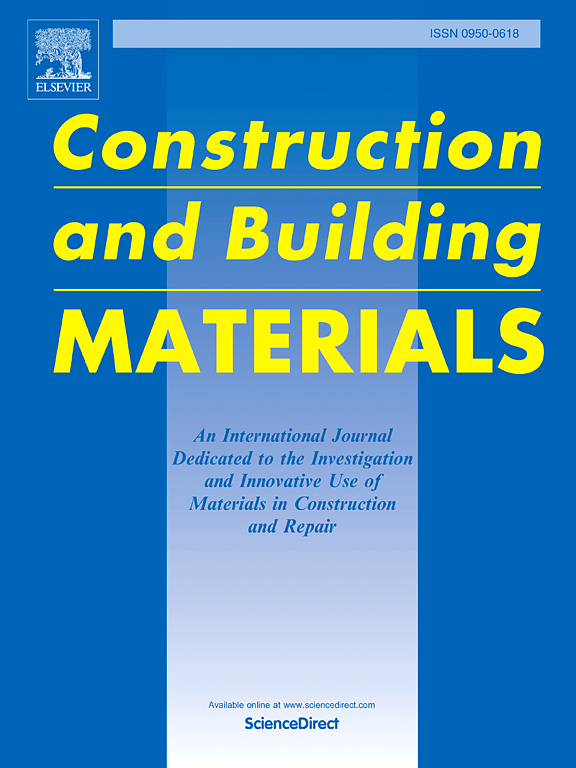Investigation on the physical, mechanical, and durability properties of ductile aerogel powder cement-based composites
IF 8
1区 工程技术
Q1 CONSTRUCTION & BUILDING TECHNOLOGY
引用次数: 0
Abstract
This study incorporated aerogel powder into cement-based composites to fabricate a ductile aerogel-powder–cement composite (DACC) with combined ductility and thermal insulation properties. Porosity characterization, thermal conductivity, compressive strength, flexural strength, and tensile strength tests were performed, followed by freeze–thaw cycling and Na₂SO₄ immersion evaluations. Results indicate that as aerogel powder content increased from 0 % to 10 %, DACC density decreased from 1.767 to 1.245 g/cm³ . At 2 %, 4 %, and 6 % aerogel content, compressive strength exceeded 20 MPa while maintaining good ductility and insulation performance. With 10 % aerogel, compressive strength dropped to 7.2 MPa and thermal conductivity reached as low as 0.269 W/(m·K). After 90 freeze–thaw cycles, DACC-10 % exhibited a mass loss of 1.76 % and an 89.2 % reduction in compressive strength. Under sulfate erosion, increasing aerogel content from 2 % to 10 % led to a 2 %–11.6 % improvement in compressive strength. Scanning electron microscopy (SEM) revealed three mechanisms of aerogel powder within the matrix—fiber–mortar–aerogel (FMA), pore–aerogel (PA), and mortar–aerogel (MA)—clarifying their respective influences on DACC performance. This research provides an effective approach for the engineering application of aerogel-powder cement-based composites.
延性气凝胶粉末水泥基复合材料的物理、力学和耐久性研究
本研究将气凝胶粉末掺入水泥基复合材料中,制备出兼具延展性和保温性能的延性气凝胶-粉末-水泥复合材料(DACC)。进行孔隙率表征、导热系数、抗压强度、抗折强度和抗拉强度测试,然后进行冻融循环和硫酸钠浸渍评估。结果表明,随着气凝胶粉含量从0 %增加到10 %,DACC密度从1.767降低到1.245 g/cm³ 。当气凝胶含量为2 %、4 %和6 %时,抗压强度超过20 MPa,同时保持良好的延性和保温性能。当气凝胶含量为 %时,气凝胶的抗压强度降至7.2 MPa,导热系数低至0.269 W/(m·K)。90次冻融循环后,DACC-10 %的质量损失率为1.76 %,抗压强度降低89.2% %。在硫酸盐侵蚀下,气凝胶含量由2 %增加到10 %,抗压强度提高2 % ~ 11.6 %。扫描电镜(SEM)揭示了气凝胶粉末在基质-纤维-砂浆-气凝胶(FMA)、孔隙-气凝胶(PA)和砂浆-气凝胶(MA)中的三种作用机理,阐明了它们各自对DACC性能的影响。该研究为气凝胶-粉末水泥基复合材料的工程应用提供了有效途径。
本文章由计算机程序翻译,如有差异,请以英文原文为准。
求助全文
约1分钟内获得全文
求助全文
来源期刊

Construction and Building Materials
工程技术-材料科学:综合
CiteScore
13.80
自引率
21.60%
发文量
3632
审稿时长
82 days
期刊介绍:
Construction and Building Materials offers an international platform for sharing innovative and original research and development in the realm of construction and building materials, along with their practical applications in new projects and repair practices. The journal publishes a diverse array of pioneering research and application papers, detailing laboratory investigations and, to a limited extent, numerical analyses or reports on full-scale projects. Multi-part papers are discouraged.
Additionally, Construction and Building Materials features comprehensive case studies and insightful review articles that contribute to new insights in the field. Our focus is on papers related to construction materials, excluding those on structural engineering, geotechnics, and unbound highway layers. Covered materials and technologies encompass cement, concrete reinforcement, bricks and mortars, additives, corrosion technology, ceramics, timber, steel, polymers, glass fibers, recycled materials, bamboo, rammed earth, non-conventional building materials, bituminous materials, and applications in railway materials.
 求助内容:
求助内容: 应助结果提醒方式:
应助结果提醒方式:


